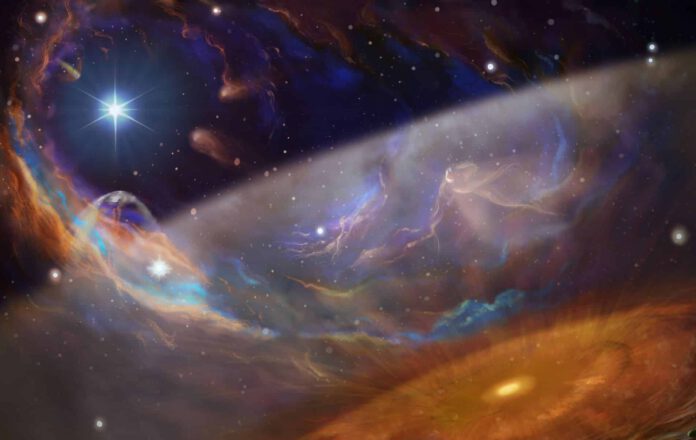
Even in the most extreme star-forming regions scientists know of, it seems possible for rocky planets like Earth to form.
It might seem unlikely that planets with a rocky composition, including planets with water, could survive in harsh environments bathed in harsh ultraviolet radiation from heavy stars. Yet, the opposite appears to be true. Using the MIRI instrument on board the powerful James Webb Telescope, astronomers have detected water and carbon-containing molecules in a disc of gas and dust around a young star, similar to our sun. Remarkably, this star resides in one of the most extreme environments in our Milky Way.
The Disc XUE-1
The team of astronomers studied the inner region of the disc, where planets with Earth-like compositions – rocky, with a thin atmosphere – are expected to develop. The disc, named XUE-1 by the astronomers, is bombarded with intense ultraviolet radiation from nearby hot, heavy stars. Yet even in these harsh conditions, the researchers discovered both water and simple organic molecules. “This result is unexpected and exciting,” says first author María Ramírez-Tannus. “It shows that there are favorable conditions for forming Earth-like planets and the ingredients for life, even in the harshest environments in our Milky Way.”
Star-forming Regions with Heavy Stars
The study provides valuable new insights into the environments in which planets similar to Earth can form. So far, little was known about how harsh environments impact the inner parts of discs. Previous detailed observations of disks where planets form were restricted to nearby star-forming regions without heavy stars.
Heavy Stars
Heavy stars are naturally very bright and emit large amounts of potent UV radiation. Their presence significantly disrupts the environment. Therefore, it was assumed that the formation of Earth-like planets here would be rare. This could not be definitively established because in the current universe, star-forming regions with heavy stars are not common. Moreover, even the nearest ones are far away. Until recently, there was no method to observe small disks around Sun-like stars in detail. The few disks that are close enough for detailed observation all reside in calmer environments devoid of the intense UV radiation of heavy stars.
The Emission Nebula NGC 6357
In an attempt to learn more, researchers decided to study the emission nebula NGC 6357 in more detail. This nebula is located 5500 light-years away from Earth, making it one of the closest heavy star-forming regions. NGC 6357 hosts more than ten bright, high-mass stars, meaning some planet-forming discs in this region have been exposed to potent UV radiation for most of their existence. “If intense radiation impedes the conditions for planet formation in the inner regions of protoplanetary disks, then NGC 6357 is the place where we should see the effect,” researcher Arjan Bik explains.
Molecules
The team was surprised to discover that at least one of the disks in NGC 6357, in terms of key molecules, doesn’t differ much from disks in areas with less heavy stars. “We found an abundance of water, carbon monoxide, carbon dioxide, hydrogen cyanide, and acetylene in the inner regions of XUE-1,” says co-author Rens Waters of Radboud University. “This provides valuable clues about the likely composition of the original atmosphere of the resulting Earth-like planets.” Scientists also discovered silicate dust, a building block for rocky planets, in comparable amounts as in areas where lighter stars are being formed.
Earth-like Planets
In conclusion, the study shows that Earth-like planets can even form under harsh conditions. The inner parts of protoplanetary disks around heavy stars appear to be just as suitable for forming Earth-like, rocky planets as those around less heavy stars. Moreover, they even provide an abundance of water, an essential ingredient for life as we know it.
The researchers can’t currently confirm with certainty whether many Earth-like planets form in such environments. Studying just one disk is insufficient for this. However, follow-up research is already in the pipeline, coauthor Lars Cuijpers, a master’s student at Radboud University, reveals. “We will do more research within our James Webb Space Telescope program on 14 more disks located in different parts of NGC 6357,” he concludes.











